There is an entire section of the model 3 manual that specifically states not to tow the car with the wheels on the ground. Whether someone wants to listen or not is another story. There is also a specific section in the manual that speaks to "towing" and that model 3 is not suitable for towing in the US, yet people do it all the time.
Before anyone jumps on me, I am just pointing out that it says "dont do this" specifically in the manual, as well as stating that it may cause things to ignite (and any damage from "improper" towing is not covered by the warranty, with "improper" being wheels on the ground towing. Since these are the most connected cars in the world, Tesla would absolutely know if the car spent miles of time on a flat grade in regen braking.
As far as the OPs question though, sure short distances in neutral should be fine, if you wanted to get to the side of the road or something.
=============================================
In the event that your vehicle needs to be towed, learn about the logistics of transporting it.
www.tesla.com
Instructions for Transporters
DO NOT TRANSPORT WITH WHEELS ON THE GROUND
The motor(s) in Model 3 generates power when the wheels spin. Always transport Model 3 with all four tires off the ground. Ensure that the tires are unable to spin at any time during transport.
Warning
NEVER TRANSPORT YOUR VEHICLE WITH THE TIRES IN A POSITION WHERE THEY CAN SPIN. DOING SO CAN LEAD TO SIGNIFICANT DAMAGE AND OVERHEATING. IN RARE CASES EXTREME OVERHEATING MAY CAUSE THE SURROUNDING COMPONENTS TO IGNITE.


Do not transport Model 3 using any method that is not specified by Tesla. Adhere to the instructions provided in the following sections and observe all warnings and cautions provided. Damage caused by improper transporting of your vehicle is not covered by the warranty.
Note
Tesla is not liable or responsible for reimbursing services not dispatched through Tesla Roadside Assistance.
Approved Methods for Transporting
A flatbed truck or comparable transport vehicle is the recommended method of transporting Model 3. The vehicle can face either direction when using a flatbed.

If Model 3 must be transported without a flatbed truck, then wheel lifts and dollies must be used to ensure that all four wheels are off of the ground. This method may only be used for a maximum of 35 miles (55 km), and must not exceed the manufacturer speed rating of the dollies. With this method, Tesla recommends the vehicle facing forward so that the front wheels are lifted and the rear wheels are on dollies.

CAUTION
Enable Transport Mode (see
Activate Transport Mode) before winching Model 3 onto a flatbed truck (see
Pull onto the Flatbed Truck). If Transport Mode is not available or the touchscreen is not accessible, self-loading dollies or tire skates must be used to load the vehicle into the approved transportation position. Tesla is not responsible for any damage caused by or during the transport of Model 3, including personal property damage or damage caused by using self-loading dollies or tire skates.
Note
Transport Mode is only intended to allow for winching Model 3 onto a flatbed truck or repositioning the vehicle out of a parking space. While in Transport Mode, the tires are allowed to rotate slowly (under 3 mph or 5 km/h) and for a very short distance (less than 30 feet or 10 meters). See
Activate Transport Mode. Exceeding these boundaries can lead to significant damage and overheating that is not covered by the warranty.
Warning
Model 3 is equipped with high voltage components that may be compromised as a result of a collision (see
High Voltage Components). Before transporting Model 3, it is important to assume these components are energized. Always follow high voltage safety precautions (wearing personal protection equipment, etc.) until emergency response professionals have evaluated the vehicle and can accurately confirm that all high voltage systems are no longer energized. Failure to do so may result in serious injury.
Activate Transport Mode
Transport Mode keeps the parking brake disengaged while winching Model 3 onto a flatbed truck. When active, Transport Mode displays a message indicating that the vehicle will remain free-rolling. To enable Transport Mode:
- Low voltage power is required. You will be unable to use the touchscreen to activate Transport Mode if Model 3 has no power.
- Model 3 must detect a key. Transport Mode is available only when a key is detected.
To activate Transport Mode:
- Ensure Model 3 is in Park.
- Chock the tires or make sure Model 3 is secure.
- Press and hold the brake pedal, then on the touchscreen, touch Controls > Service > Towing. The touchscreen displays a message reminding you how to properly transport Model 3.
- Press and hold the Transport Mode button until it turns blue. Model 3 is now free-rolling and can slowly be rolled (no faster than walking speed) or winched.
To cancel Transport Mode, shift Model 3 into Park.
Note
If your vehicle is equipped with a lead-acid low voltage battery (see
Jump Starting): Transport Mode may cancel if Model 3 loses low voltage power after Transport Mode is enabled.
CAUTION
If the electrical system is not working, and you therefore cannot use the touchscreen to activate Transport Mode, use self-loading dollies or tire skates. Before doing so, always check the manufacturer's specifications and recommended loading capacity.
Pull onto the Flatbed Truck
Note
If Model 3 has no low voltage power, you need an external low voltage power supply to open the hood or use the touchscreen (see
Jump Starting).
CAUTION
To avoid damage, only pull the vehicle onto a flatbed truck using a properly-installed tow eye. Using the chassis, frame, or suspension components to pull the vehicle can result in damage.
- Locate the tow eye. The tow eye is located in the front trunk.

- Release the tow eye cover by pressing firmly on its top right perimeter until it pivots inward, then gently pull the raised section toward you.
Note
The tow eye cover is connected to the vehicle's black negative (-) terminal.

- Fully insert the tow eye into the opening, then turn it counter-clockwise until securely fastened.

- Attach the winch cable to the tow eye.
CAUTION
Before pulling, make sure the tow eye is securely tightened.
- Activate Transport Mode.
- Pull Model 3 slowly onto the flatbed truck.
Secure the Tires
The vehicle's tires must be secured onto the truck using the eight-point tie-down method:
- Ensure any metal parts on the tie-down straps do not contact painted surfaces or the face of the wheels.
- Do not place tie-down straps over the body panels or through the wheels.
CAUTION
Attaching the tie-down straps to the chassis, suspension or other parts of the vehicle's body may cause damage.

If Vehicle Has No Power
If Model 3 has no low voltage power, perform the following steps to open the hood or jump start the low voltage battery.
- Open the hood. See Opening Hood with No Power for more information on opening the hood if the vehicle does not have power.
- Jump start the low voltage battery (see Jump Starting).
Note
Tow providers: See
Running Out of Range for more information on transporting the vehicle to a charging station and preparing the vehicle to charge.
CAUTION
Because the windows automatically lower slightly when you open or close a door, always connect to an external, low voltage power supply before opening a door if the vehicle has no power to avoid breaking a window (see
Jump Starting).











